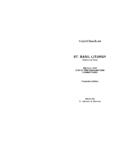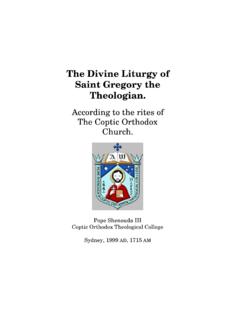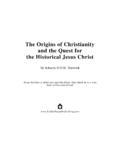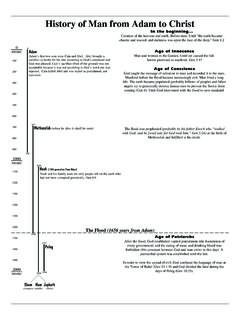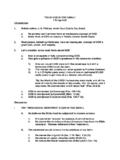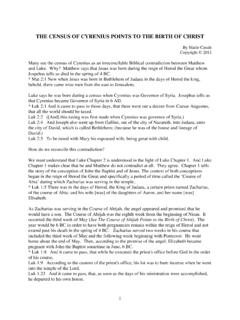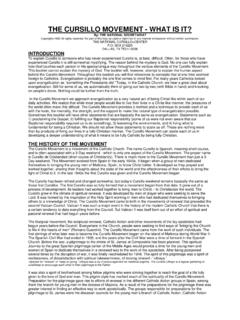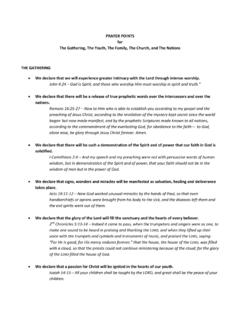Transcription of The Nature of Christ - Coptic Orthodox Church …
1 St. Mark Coptic Orthodox Church427 West Side Ave,Jersey City NJ 07304 TTHHEE NNAATTUURREE OOFF Pope Shenouda III 1999 Internet: : TThhee NNaammee,, tthhee FFaatthheerr aanndd tthhee SSoonnAAnndd tthhee HHoollyy SSppiirriittH. H. Pope Shenouda IIIP atriarch of the See of St. Mark2 Table of Contents1. The Orthodox Concept Concerning The Nature of Christ2. The Widely known Heresies Concerning The Nature of Christ3. The Nature of this Union4. The Unity of Nature and the Birth of Christ5. Possibility of such Unity6. The Importance of the "One Nature " For Propitiation and Redemption7.
2 The One Nature and the Suffering8. The Term "Son of Man"9. Evidences from the Bible10. The One Will and the One Act31 The Orthodox ConceptConcerningThe Nature of ChristThe Lord Jesus Christ is God Himself, the Incarnate Logos Who took to Himself aperfect manhood. His Divine Nature is one with his human Nature yet without mingling,confusion or alteration; a complete Hypostatic Union. Words are inadequate to describethis union. It was said, that without controversy, "Great is the mystery of godliness, Godwas manifest in the flesh. " (I Tim. 3:16).As this union is permanent, never divided nor separated, we say in the liturgy that HisGodhead never departed from His manhood for a single moment nor even for a twinkleof an Divine Nature (God the Word) was united with the human Nature which He took ofthe Virgin Mary by the action of the Holy Spirit.
3 The Holy Spirit purified and sanctifiedthe Virgin s womb so that the Child to whom she gave birth would inherit nothing of theoriginal sin; the flesh formed of her blood was united with the Only-Begotten Son. ThisUnity took place from the first moment of the Holy Pregnancy in the Virgin s a result of the unity of both natures-the Divine and the human-inside theVirgin s womb, one Nature was formed out of both: "The One Nature of God theIncarnate Logos" as St. Cyril called Holy Church did not find an expression more reliable, deep and precise than thatwhich was used by St.
4 Cyril the Great, and which St. Athanasius the Apostolic usedbefore him. Both of them were true leaders in the theological field I participated in the dialogue arranged by the Pro-Oriente group in Vienna,Austria in September 1971 between the Roman Catholic Church and the ancientOriental Orthodox Churches concerning the Nature of Christ , the point of discussionwas St. Cyril s expression "One Nature of God the Incarnate Logos" (Mia Physis TouTheou Logou Sesarkwmene).After the schism which took place in the year 451 , when the Coptic OrthodoxChurch rejected the motions of the Council of Chalcedon and its theological struggles,we were called "Monophysites" that is, those who believe in the "One Nature ".
5 Sharing our belief are the Syrians, the Armenians, the Ethiopians and the Indians; whowere also called "Non-Chalcedonian" Orthodox the other hand, the Chalcedonian Catholic and Creek Churches "The RomanOrthodox" believe in the two natures of Christ ; the Protestant Churches also hold , these churches are known as "Diophysites" - believers in the two naturesof Roman - or Chalcedonian - Orthodox Churches include those of Constantinople,Greece, Cyprus, Russia, Romania, Hungary and Serbia as well as the Roman OrthodoxChurches of Egypt, Syria, Lebanon, America and the St.
6 Catherine Monastery in theSinai term "Monophysites" used for the believers in the One Nature has beenintentionally or unintentionally misinterpreted throughout certain periods of , the Coptic and the Syrian Churches in particular were cruelly persecutedbecause of their belief, especially during the period which started from the Council ofChalcedon held in 451 A,D. and continued to the conquest of the Arabs in Egypt andSyria (about 641 ).This misinterpretation continued along history as though we believed in onenature of Christ and denied the other wonder which of the two natures the Church of Alexandria denies?
7 Is it the Divine Nature ? Certainly not, for our Church was the most fervent defenderagainst the Arian heresy in the Council of Nicea, held in the year 325 , as well asbefore and after that. Or is it The Lord s human Nature that the Church of Alexandriadenies? St. Athanasius of Alexandria resolved this entirely in the oldest and greatestbook on this subject The Incarnation of the Word,The expression "One Nature " does not indicate the Divine Nature alone nor thehuman Nature alone, but it indicates the unity of both natures into One Naturewhich is "The Nature of the Incarnate Logos".
8 The same applies when we speak about our human Nature which comprises two unitednatures: the soul and the body. Thus, man s Nature is not the soul alone nor the bodyalone, but their union in one Nature called human Nature . We will discuss this point indetail later Cyril the Great taught us not to talk about two natures after their we can say that the Divine Nature united hypostatically with the human Nature withinthe Virgin s womb, but after this unity we do not ever speak again about two natures ofChrist. In fact, the expression "two natures" implies in itself division or separation, andalthough those who believe in "the two natures" admit unity, the tone of separation wasobvious in the Council of Chalcedon - a matter which prompted us to reject the Counciland caused the exile of St.
9 Dioscorus of we go further in explaining the subject of the One Natures and the two natures ofChrist, we would like to give a brief description of the widely known heresies concerningthe Nature of Widely known HeresiesConcerningThe Nature of Christ A) The Heresy of Arius (Arianism):Arius denied the Divinity of the Lord Jesus Christ ; he considered that Christ was notconsubstantial with the Father and that He was created. The roots of Arianism still existuntil this day. Even after being condemned in 325 by the Council of Nicea, Ariusand his followers caused trouble, dissension and suspicions within the Holy ) The Heresy of Apollinarius:Apollinarius preached the Divine Nature of Christ , but did not believe in His completehuman Nature ; he considered that the human Nature of Christ was not in need of a souland thus He was without soul because God the Logos provided the needed life.
10 As thisimplied that the human Nature of Christ was incomplete, the Holy Ecumenical Council ofConstantinople held in 381 condemned Apollinarius and rejected his idea declaringit a ) The Heresy of Nestorus (Nestorianism):Nestorus was Patriarch of Constantinople in 428 , he was excommunicated by theHoly Ecumenical Council of Ephesus held in 431 because he refused to name theVirgin St. Mary "Mother of God" (Theotokos). He believed that St. Mary gave birth to amere human and that Divinity descended and filled this human; Thus the Virgin Marywould be called the "Mother of Jesus" (Christokos), and not the "Mother of God"(Theotokos).
